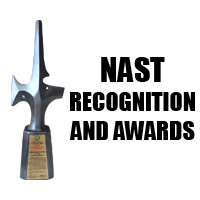DILIMAN, QUEZON CITY – The National Academy of Science and Technology, Philippines (NAST PHL), through the Agricultural Sciences Division, organized the Science Policy and Information Forum 2018 with the theme “Caring for our Galunggong (Roundscad) and Tilapia Fisheries for Food Security” on November 7, 2018 at Max’s Restaurant, Quezon City Circle, Diliman Quezon City.
The information and policy forum was conducted to (1) discuss the importance of galunggong and tilapia for the country’s food security, (2) identify the issues and reasons why the supply of galunggong and tilapia have dropped and why prices for the commodities have increased, and (3) formulate recommendations to sustain the supply of galunggong and tilapia in the country for food security. The forum was attended by nearly a hundred participants from different government agencies, academic and research institutions, non-government organizations, and media outlets.Highlighting the importance of developing the blue economy and the need to act on the alarming situations of two major commodities (galunggong and tilapia), NAST President Rhodora V. Azanza welcomed and invited the participants to continue campaigning for the sustainable development of the blue economy which includes fisheries and marine resources.
Academician Rafael D. Guerrero III, one of the focal persons of the activity and member of the NAST PHL Agricultural Sciences Division, discussed the objectives of the forum. He also emphasized the timeliness and relevance of the forum’s topic.
Dr. Nygiel B. Armada, chief of party of the USAID FishRIGHT Project, talked about “Roundscad Fishery and the Northern Palawan Fishing Closure”. He provided a brief description of the various species of Roundscad in Northern Palawan, which accounts for 92% of the landed catch at the Navotas fish port and comprises 22% of the total landed catch nationwide. He also expounded on the declining catch of roundscads in the Philippines brought by overfishing and climate change, and explained if seasonal closure works.
Undersecretary Eduardo B. Gongona, National Director of Bureau of Fisheries and Aquatic Resources (BFAR), talked about the government’s efforts to boost the galunggong and tilapia industries. He explained projection of fish sufficiency level, which, currently is 92% sufficient and projected to reach 102% by 2023. He then explained some factors affecting the losses and provided envisioned impacts through the Development Program for the Tilapia Industry (2018-2022). He then called on to the attendees to take care of the municipal waters in order to sustain and further develop the whole fishing/tuna industry.
The third lecture on “Roundscad Fishery and Fishing Lights (VIIRS Boat Detection) in the Philippine Seas” was delivered by Mr. Rollan C. Geronimo from the Department of Geography of the University of Hawaii at Manoa. He showed graphs of declining galunggong catch trends and explained possible explanations such as fishing effort reduction, change in fishing locations, unaccounted fishing, and environmental changes. He also explained imaging results using Visible Infrared Imaging Radiometer Suite (VIIRS) and other satellite-derived information.
The Executive Director of the Philippine Council for Agriculture, Aquatic, and Natural Resources Research and Development (PCAARRD), Dr. Reynaldo V. Ebora, delivered his lecture on the “Potential of Galunggong and Tilapia for the Country’s Food Security”. He enumerated the issues and challenges faced in the production of the two commodities and specified the needs of the industry. He also shared some updates on the efforts done and the technologies used to improve production. To provide a benchmark, he suggested areas that could be explored through research and development and collaboration of various public and private agencies.
To provide an assessment of the farmed Tilapia production in the Philippines from 2007 to 2016, Academician Rafael D. Guerrero III discussed the production trends and provided recommendations for future actions. He also expounded on the major causes of low Tilapia production, which includes high water temperature, lack of government assistance, poor breed of tilapia, high cost of production, and lack of capital.
To synthesize the inputs of the speakers and attendees, Dr. Angel B. Encarnacion, Outstanding Young Scientist 2018, gave a brief recap of the event. Academician Eufemio T. Rasco, Jr., chair of the Agricultural Sciences Division, delivered the closing remarks, encouraging everyone to be committed in the development of the blue economy for food security.
During the forum, salient recommendations were given in relation to the fisheries situation in the country. These include the renewed call for the creation of a Department of Fisheries and Oceans or a similar entity, the drive for an enhanced national talent retention mechanism, and harmonized Commission on Audit (COA) rules on research and development (R&D). It was pointed out that these recommendations are essential in order to develop the country’s blue economy, and consequently, ensure food security for all.
Academician Mudjekeewis D. Santos, one of the focal persons of this activity and member of the Agricultural Sciences Division, served as the moderator of the event.
NAST PHL is an attached agency to the Department of Science and Technology (DOST) and serves as the country’s premier recognition and advisory body on science and technology.











